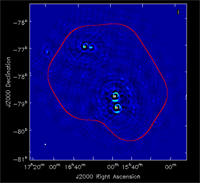First continuum image achieved with six ASKAP antennas10 February 2014 Members of the commissioning team have successfully produced the first continuum image using six ASKAP antennas at the Murchison Radio-astronomy Observatory (MRO) in Western Australia. The six antennas were operated simultaneously as two separate 3-antenna arrays, with each sub-array producing a separate image. This is a milestone in itself and the best results produced to date using ASKAP antennas installed with phased array feed (PAF) receivers. When combined, these two sub-arrays represent BETA – the Boolardy Engineering Test Array. As the first six ASKAP antennas installed with PAFs (and associated digital systems), BETA provides an essential engineering testbed for the ASKAP team to prepare for the full fit-out of ASKAP. To create the first image, the team used ASKAP Antennas 1, 3, and 6 – used in previous commissioning tests – but for the first time took advantage of the full 304 MHz bandwidth available to BETA. This bandwidth is more than twice the minimum BETA specification. The additional sensitivity gained from the full bandwidth allowed the identification of a number of weaker sources not previously visible in earlier images. Next, the team turned their attention to the second sub-array, made up of ASKAP Antennas 8, 9 and 15. A fringe-rotator was required for this array, due to the longer baselines involved. The resulting image was then combined with the first to create the first ever six-antenna BETA image. According to John Reynolds, ASKAP Systems Scientist, the data was processed using the now live ASKAP Central Processor at the iVEC Pawsey Centre. "For the first time, we have had access to the RTC (Cray Real-Time Computer) at the Pawsey Centre, which really helped with the serious number-crunching you need for image processing," he said, "Having this resource online is now making a big difference to our commissioning efforts." Further refinement of the software and firmware required to create this image will provide a more stable system. Upcoming priorities will also be to reconfigure the system to a 6-station correlator, rather than the two simultaneous 3-antenna sub-arrays that were used for this result. Back to Latest ASKAP News page. |
This loads a font easier to read for people with dyslexia.
This renders the document in high contrast mode.
This renders the document as white on black
This can help those with trouble processing rapid screen movements.

